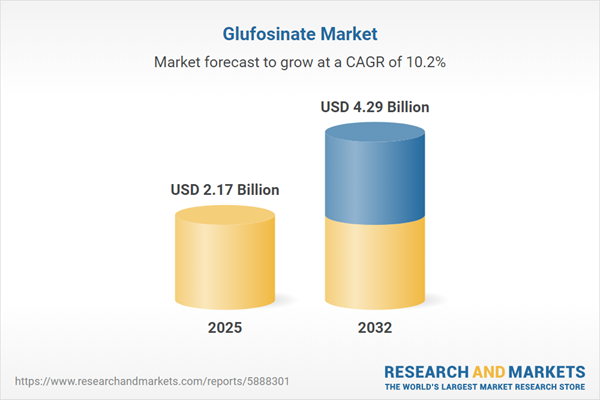Speak directly to the analyst to clarify any post sales queries you may have.
The glufosinate market is rapidly evolving as key players in agriculture seek innovative approaches to control resistant weeds, balance sustainability, and comply with shifting regulations. Decision-makers are leveraging adaptive crop protection strategies to maintain competitiveness in a complex global environment.
Market Snapshot: Glufosinate Market Growth & Outlook
Strong and consistent demand for glufosinate is being driven by its proven effectiveness in managing resistant weed species, alongside seamless compatibility with next-generation crop management platforms. The sector is advancing with steady growth, buoyed by accelerated uptake in primary agricultural economies and technical improvements in application and formulation. In parallel, the industry is prioritizing regulatory adaptability and operational resilience as persistent supply chain unpredictability prompts leading companies to pursue robust investment in distribution and continuity strategies.
Scope & Segmentation: Complete Industry Coverage of Glufosinate
This comprehensive report equips senior executives with detailed analysis of the glufosinate sector, offering practical insights into key operational and market drivers across multiple dimensions:
- Application: Covers the use of glufosinate in post-emergence and pre-emergence foliar sprays, seed treatments targeting specific crops, and adaptable soil management practices. Each approach provides flexibility for evolving agronomic requirements and diverse commercial production systems.
- Crop: Examines primary crops including corn, soybean, and wheat, with attention to regional variation in weed resistance and the unique economic factors influencing product adoption in different agricultural landscapes.
- Formulation: Profiles key product types such as dry flowables, liquid concentrates, and water-dispersible granules, emphasizing the importance of operational efficiency, workplace safety, and the reduction of process-related waste.
- End Use: Analyzes glufosinate applications spanning commercial agriculture, industrial vegetation control, and residential turf, ensuring comprehensive perspectives on operational demands and adherence to industry protocols.
- Regions: Investigates regional trends and regulatory landscapes across the Americas, Europe, Middle East & Africa, and Asia-Pacific, with emphasis on localized supply chain infrastructure, compliance requirements, and ongoing digital transformation efforts shaping market access and efficiency.
- Companies: Details the activities of global leaders and regional entrants, with analysis of pipeline development, innovative service models, and partnership strategies positioned to foster differentiation and capitalize on emerging opportunities.
Key Takeaways for Decision-Makers
- Integrated resistance programs increasingly hinge on glufosinate to close gaps where alternative herbicides are losing effectiveness due to evolving weed resistance patterns.
- Recent advancements such as nano-emulsion technology and sensor-guided applications are enabling more precise herbicide dosing while supporting adherence to stricter safety standards.
- Widespread adoption of digital agriculture platforms facilitates live weed monitoring, resource optimization, and operational improvement consistent with precision farming methods.
- Continuous product and portfolio innovation is becoming critical as market expectations for sustainability and evolving compliance standards drive corporate strategy.
- Regional supply chain risk mitigation is fueling a shift towards near-shoring and localized production to reinforce procurement reliability and accommodate logistical shifts.
- Successful expansion within the glufosinate market depends on rigorous attention to local regulations and the degree of digital integration, supporting the execution of region-specific operational strategies.
Tariff Impact: Navigating U.S. Trade Shifts
Recent revisions to United States tariffs for glufosinate inputs are prompting companies to revisit sourcing channels and pricing frameworks across the sector. This dynamic is accelerating a move towards increased domestic production and deeper supplier engagement. Senior executives are emphasizing risk management targeted at tariff exposure, operational localization, and comprehensive forward-planning. These actions are designed to optimize procurement and contracting practices against the volatility of the current trade environment.
Methodology & Data Sources
To inform this report, a multi-faceted research approach was used, pairing technical reviews of compliance materials and regulatory files with expert interviews, industry panels, and proprietary market database analysis. Quantitative modeling provides actionable, scenario-based frameworks for executive decision-making.
Why This Report Matters
- Offers directors and strategy leaders clear guidance to realign investment strategies and operational focus as glufosinate market trends evolve.
- Empowers sourcing and operations teams to strengthen supply chains, integrate novel technologies, and address region-specific challenges for market entry and compliance.
- Enables organizations to anticipate sector changes and drive improvements in sustainable agricultural practices and operational efficiency.
Conclusion
This analysis supports senior stakeholders as they refine market approaches, implement responsive solutions, and navigate shifting regulatory and operational conditions within the glufosinate sector.
Additional Product Information:
- Purchase of this report includes 1 year online access with quarterly updates.
- This report can be updated on request. Please contact our Customer Experience team using the Ask a Question widget on our website.
Table of Contents
3. Executive Summary
4. Market Overview
7. Cumulative Impact of Artificial Intelligence 2025
List of Figures
Samples

LOADING...
Companies Mentioned
The key companies profiled in this Glufosinate market report include:- BASF SE
- Bayer AG
- UPL Limited
- ADAMA Ltd
- Nufarm Limited
- Sipcam Oxon S.p.A
- Sumitomo Chemical Co., Ltd
- Zhejiang Xinan Chemical Industrial Group Co., Ltd
- Gowan Company LLC
- Qingdao Seawin Biotech Group
Table Information
| Report Attribute | Details |
|---|---|
| No. of Pages | 194 |
| Published | October 2025 |
| Forecast Period | 2025 - 2032 |
| Estimated Market Value ( USD | $ 2.17 Billion |
| Forecasted Market Value ( USD | $ 4.29 Billion |
| Compound Annual Growth Rate | 10.2% |
| Regions Covered | Global |
| No. of Companies Mentioned | 11 |









